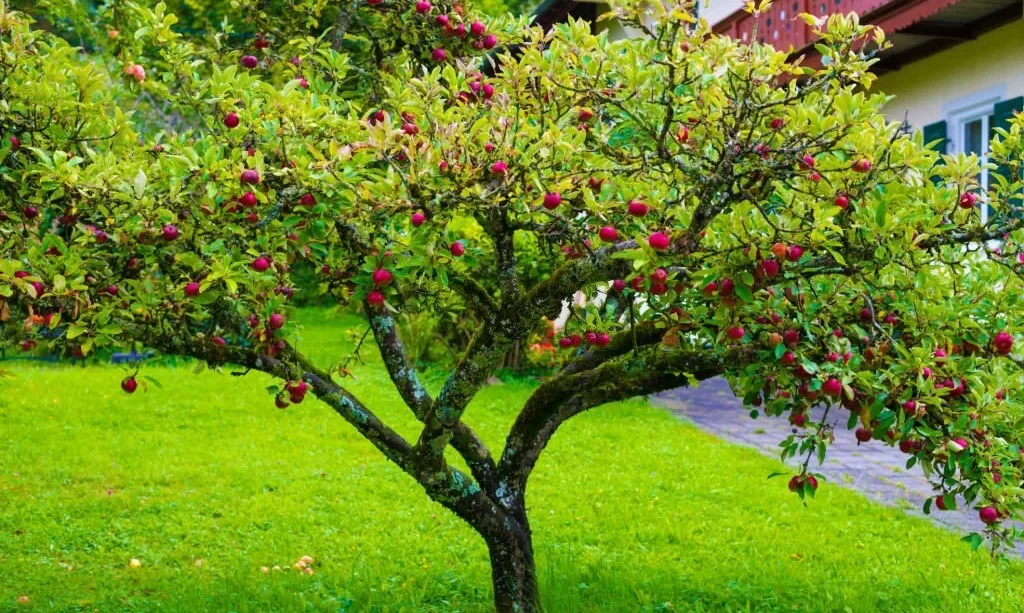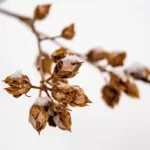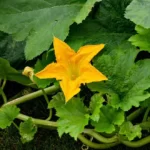When it comes to apple cultivation, Florida might not be the first place that comes to mind. Known for its warm and humid climate, Florida is often considered an unlikely candidate for growing apples. However, in this article, we will delve into the intriguing question of whether it’s possible to grow apples in the Sunshine State. While there are challenges to overcome, the prospect of enjoying homegrown apples in Florida is not out of reach. Let’s explore the possibilities, the varieties that thrive in this unique climate, and the steps needed to make apple cultivation in Florida a reality.
- Includes special blend fertilizer & planting guide
- Produces fruit as a young tree
- Low chill hours required
- Edible, sweet fruit
- Sorry, this item DOES NOT ship to CA or AZ due to State Laws***’
Apple Trees
Before we dive into the specifics of growing apples in Florida, it’s essential to understand the nature of apple trees:
- Growth Habits: Apple trees are deciduous and typically grow in a range of shapes and sizes, including dwarf, semi-dwarf, and standard varieties.
- Preferred Growing Conditions: Apple trees prefer well-draining soil, adequate sunlight (usually 6-8 hours of direct sun per day), and a specific number of winter chill hours to produce fruit.
Florida’s Climate and Apple Cultivation
Florida’s climate is characterized by its diversity, with varying zones that present unique challenges and opportunities for apple cultivation:
- Temperature and Humidity: Florida’s high temperatures and humidity levels can pose challenges for apple trees. The excessive heat and humidity can affect fruit development and increase the risk of diseases.
- Lack of Winter Chill Hours: Many traditional apple varieties require a certain number of winter chill hours (hours below a specific temperature) to break dormancy and set fruit. Florida’s mild winters often lack the necessary chill hours.
- Climate Zones: Florida is divided into several climate zones, from the subtropical south to the more temperate north. Different zones may have varying success with apple varieties, making it essential to choose varieties suited to your specific location.
While Florida’s climate might seem incompatible with apple cultivation, there are apple varieties specifically bred or adapted to thrive in warmer climates. In the following sections, we will explore these varieties and the strategies needed to successfully grow apples in the Sunshine State.
- Includes special blend fertilizer & planting guide
- Thives in warm climates
- Edible fruit
- Low chill hours, Self fertile
- Sorry, this item DOES NOT ship to CA or AZ due to State Laws***’
Suitable Apple Varieties for Florida
In the quest to grow apples in Florida’s unique climate, the choice of apple varieties plays a pivotal role. Here are some apple varieties that have shown promise in the Sunshine State:
- Anna Apple: Anna apples are well-suited for Florida’s warm climate. They require minimal chill hours and produce sweet and crisp fruits.
- Dorsett Golden Apple: Another excellent choice for Florida, Dorsett Golden apples are heat-tolerant and require relatively low chill hours. They yield juicy, golden-yellow fruits.
- TropicSweet Apple: As the name suggests, TropicSweet apples are designed for tropical and subtropical climates. They produce sweet and aromatic apples with a distinctive tropical flavor.
- Ein Shemer Apple: This Israeli variety thrives in warm climates and can produce two fruit crops a year in Florida’s conditions. The apples are crisp and flavorful.
- Southern Home Apple: Specifically developed for the South, these apples can handle the heat and humidity. They are known for their sweet and juicy fruits.
Preparing Your Garden for Apple Trees
Creating the right environment for apple trees in your Florida garden is crucial for their success:
- Location: Choose a spot with well-draining soil and adequate sunlight. Apple trees generally require full sun, so aim for a location that receives at least 6-8 hours of direct sunlight daily.
- Soil Preparation: Test your soil and amend it as needed to provide optimal conditions for apple trees. Ensure good drainage and consider raised beds if your soil is heavy or poorly draining.
- Spacing: Plant apple trees with enough space between them to allow for proper air circulation, which helps prevent disease.
Planting and Caring for Apple Trees
Planting and caring for apple trees in Florida requires attention to detail:
- Planting Time: Choose the right time to plant apple trees. In Florida, late winter to early spring is generally the best time to plant, allowing the tree to establish roots before the hot summer.
- Watering: Consistent and deep watering is essential, especially during the dry season. Use mulch to help retain soil moisture and protect the roots.
- Fertilization: Apply a balanced, slow-release fertilizer in late winter or early spring, following the recommended dosage for your tree’s size and age.
- Pruning: Regular pruning helps shape the tree, improve air circulation, and remove dead or diseased branches. Prune during the dormant season.
By selecting suitable apple varieties, preparing your garden thoughtfully, and providing proper care, you can increase your chances of successfully growing apples in Florida’s challenging climate.
Pest and Disease Management
In Florida’s warm and humid climate, apple trees can be susceptible to various pests and diseases. Here’s how to effectively manage these challenges:
- Common Pests: Be vigilant for pests like aphids, scale insects, and mites, which can harm apple trees. Consider using natural predators like ladybugs or releasing beneficial nematodes for biological control.
- Fungal Diseases: Florida’s humidity can create conditions favorable for fungal diseases like apple scab and powdery mildew. Apply organic fungicides or neem oil preventatively to reduce the risk.
- Fire Blight: This bacterial disease can affect apple trees during warm, wet periods. Prune affected branches promptly and disinfect pruning tools to prevent its spread.
Pruning and Training
Proper pruning and training of apple trees are essential for their health and fruit production:
- Pruning Techniques: Prune during the dormant season to remove dead, diseased, or crowded branches. Training apple trees into an open center or modified central leader shape helps with air circulation and sunlight exposure.
- Thinning Fruits: Thin young fruit clusters to promote larger, healthier apples. Leave space between apples to prevent overcrowding.
- Annual Pruning: Regularly prune to maintain the desired shape and encourage new growth while removing old, unproductive wood.
- Make Pruning Work Easier: Rust-resistant stainless steel blade are sharp and durable for easy and smooth cut.Anti-slip and ergonomic handle make the gardener clippers more comfortable in your hand.Easy-open spring action reduces hand fatigue while cutting. you can easily to cut without damaging the vital stems and branches of your plants
- User-friendly Safety Lock: These garden shears have locking mechanisms to keep the sharp blades securely closed when not in use.It is easy to maneuver and can effectively reduce accidental injuries. And the closing mechanism is firmly enough, you don’t need to worry the plant pruning shears will get locked accidentally during use
- Garden Gloves for Hand Protection: One size fits most. This Gardening gloves,made of soft & comfortable cotton fabric,can protect yourself from dirt, skin wounds and nasty splinters when doing yard chores. The grip latex coating provides anti-slip or sure control when grabbing garden & yard tools
- Widely Used: This gardening shears set comes with 3 different blades for a variety of general pruning tasks.It is ideal for harvesting or trimming herbs,flowers,house plants, hydroponics,bonsai,cutting stems or light branches,or other cutting needs in the garden. It would also be a perfect gift for a gardening friend
- Customer support: Please feel free to tell us if you have any questions about our garden shears pruning. Note:Keeping your pruner shears cleaned and well-oiled can extend their lifespan. Please dry and clean it after use. Note: The colors of the garden pruners and gloves will be shipped at random
Protecting Apple Trees from Extreme Weather
Florida’s climate can be unpredictable, with extreme weather events like hurricanes, heavy rainfall, and high winds. Protecting your apple trees is crucial:
- Windbreaks: Plant windbreaks or install windbreak barriers to shield apple trees from strong winds. This helps prevent branch breakage and fruit loss.
- Shade Cloth: During intense summer heat, consider using shade cloth to reduce sun exposure and prevent sunscald on the tree’s bark.
- Hurricane Preparation: In the event of an approaching hurricane, secure your apple trees by staking or tying them to prevent them from toppling over. Prune any overhanging branches to minimize wind resistance.
By implementing these strategies, you can effectively manage pests and diseases, maintain your apple trees’ health through proper pruning, and protect them from the occasional extreme weather events that Florida may experience. With dedication and care, your apple trees can thrive and reward you with delicious, homegrown fruit in the Sunshine State.
- 【55% Shading Rate】Made of 100% New High Density Polyethylene (HDPE) fabric material, has a shading rate up to 55% can avoiding direct sunlight while allowing free air circulation.
- 【2-3 Years Service Life】Refuse to use recycled materials, tear resistant, high temperature resistance, glossy, safe and odorless, lightweight and durable.
- 【Easy To Install】Package content: 1 piece-shade cover, Average 50 cm for an aluminum buckle, You can fix the sunblock shade on anywhere with zip-tie or rope, easy to hang up.
- 【Widely Used】The shade tarp is widely used in outdoor, canopy, backyard, deck, gazebo, pergola, porch, swimming pool, dump truck, greenhouse, garden, flowers, poultry house, succulent plants, tomatoes, barn, dog kennel, cattle chicken coop, etc.
- 【Designed for You】You can use our shading net to provide you with cool and comfortable areas in summer, it’s great solution for shading, meet your different needs.
Harvesting and Enjoying Florida Apples
The moment you’ve patiently awaited has arrived—harvesting your Florida apples! Here’s how to savor the fruits of your labor:
- Harvest Timing: Apples are ready for picking when they easily come off the tree when gently twisted. Pick them with the stem intact.
- Storage: Store your freshly harvested apples in a cool, dark place with good ventilation. If you plan to store them for an extended period, consider a refrigerator or a cool basement.
- Preservation: Enjoy your apples in various ways, from fresh snacking to making pies, applesauce, or cider. You can also experiment with drying or canning them for long-term use.
- Sharing the Bounty: If your apple tree yields more than you can consume, consider sharing the harvest with friends, family, or neighbors. It’s a great way to build community bonds and share the joy of homegrown produce.
Conclusion
Growing apples in Florida might present unique challenges, but it’s an endeavor that can be immensely rewarding. With careful planning, variety selection, and attentive care, you can indeed enjoy the sweet taste of success in your own backyard.
While Florida’s climate may differ from traditional apple-growing regions, the varieties bred for warmth and your dedication can overcome these hurdles. So, don’t be discouraged by the stereotypes; instead, embrace the opportunity to cultivate delicious, homegrown apples in the Sunshine State.
As you embark on this apple-growing journey, remember that gardening is as much about the experience and the lessons learned as it is about the harvest. Each season brings new insights and a deeper connection to the rhythms of nature. So, roll up your sleeves, put on your gardening gloves, and savor the satisfaction of nurturing apple trees that thrive in Florida’s challenging but ultimately rewarding environment. Here’s to a fruitful harvest and the joy of savoring your very own Florida-grown apples!








